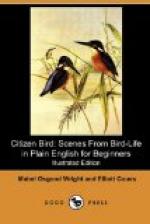“A society of House People who study American birds and decide by what name it is best to call each species, so that each may be known everywhere by the same name. This Brown Thrasher is sometimes called Song Thrush, Brown Thrush, Brown Mockingbird, and Mavis—though the first and the last of these four names belong only to a kind of European Thrush that is never found in this country. You see how confusing this is, and how much better it is for the Wise Men, who know him intimately, to give him one name you can be sure is right.”
The Catbird.
Length between eight and nine inches.
Upper parts slate color.
Crown, bill, feet, and tail black.
Under parts lighter grayish-slate color, except a chestnut-red patch under the tail.
A Summer Citizen of the United States.
A Ground Gleaner, Tree Trapper, and Seed Sower.
THE BROWN THRASHER
“As I told you a moment ago, this handsome clean-built bird with keen eyes, curved bill, and long graceful tail that opens and shuts like a fan, has several names besides that of Brown Thrasher, which seems the most suitable for him.”
“He looks redder than brown, for we called the Wood Thrush ‘brown,’” said Nat.
“Yes, his back is a much brighter brown than that of any Thrush, and this will show you the need in studying birds of being able to distinguish between several shades of the same color. There are words to represent these different grades of color, such as ‘rufous’ for reddish-brown and ‘fuscous’ for dusky-brown; these you must learn later on, for some of them are pretty hard ones. Now it is better for you to use words whose meaning is perfectly familiar to you.
“The brown of this Thrasher, you see, is brighter than that of the Wood Thrush; it is a ruddy brown, with a faint brassy glint, something like a polished doorknob, particularly when the sun strikes his back.”
“How he scratches round upon the ground,” said Dodo; “just like a hen. Why doesn’t he belong to the Birds that Scratch?”
“Because, for one reason, his feet have the three toes in front and the one behind, all on the same level; this makes him a perching bird.”
“Don’t all birds sit on a perch when they go to sleep?” asked Dodo.
“By no means. The perching birds grasp a twig firmly with their very limber toes and sharp claws, and put their head under their wing; but many others, like tame Geese and Ducks, sleep standing on the ground on one foot or sometimes floating on the water.
“The Thrasher is a Ground Gleaner, who spends most of his time in the underbrush, having a great appetite for the wicked May beetle; but he does not live near the ground only, mounting high in a tree when he wishes to sing, as if he needed the pure high air in order to breathe well, and he never sings from the heart of a thick bush, as the Catbird does so frequently.




